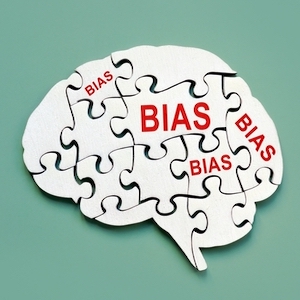By Dr. Ken Broda-Bahm:

It’s one of the central contradictions of the law: we ask for and expect neutral and unbiased decision makers…and then we end up using humans. Those human fact-finders are almost inevitably going to have an individual form of perception or some level of partiality or bias. When it comes to the question of whether it is possible to discover those biases, or to “debias,” by eliminating or minimizing them, that is both a theoretical and a deeply practical concern for legal persuaders. Those who have dug into the social science literature in the context of juries (e.g., Nadelhoffer, 2008) have found that there are four layers or levels that need to be addressed in assessing whether a given bias can be weakened or countered. But here’s the catch: none of the steps are easy.
The four steps in assessing or addressing bias in a litigation context are: 1. Awareness (we need to acknowledge that a potential fault in our perceptions and decision-making exists); 2. Motivation (we need to want to control and alleviate that fault); 3. Orientation (we need to understand the nature and the direction of the effect that bias can have on our decision-making); and finally 4. Control (we need to have the ability to regulate our own thoughts enough to counter that bias). There are many conceivable situations where even well-meaning people will fail at one or more of those levels. Still, I think that knowing about these four steps is important. By keeping these steps in mind when thinking about the degree of bias we’re likely to face, or when strategizing ways to mitigate a known bias, we are better able to understand the situation. In this post, I’ll take a look at each of these steps.
Step One: Awareness
This first step is trickier than it may seem. Particularly in the formality of a courtroom, judges and jurors have a strong belief in what is called the “illusion of objectivity.” We all want to believe that we can strictly follow instructions and base our decisions rationally only on the facts and the law. So the first step is understanding that objectivity is an ideal, and the task of getting close to it can be difficult. Decision-makers need to understand that there are psychological processes at work that could consciously or unconsciously influence their views.
Build Awareness by tapping into examples that people are already familiar with. For example, we all intuitively grasp the “Monday morning quarterback” fault in imposing current knowledge on a past decision, which is why that metaphor can be a useful shorthand introduction to hindsight bias.
Step Two: Motivation
Rational people will often presume that everyone wants to be rational. One effect of law school training is the adaption of a systematic way of thinking, and fully embracing that cognitive habit can make it harder to understand those who don’t follow it. One hard fact is that many people are just fine with their biases because they believe those biases to be truths. In order to effectively understand and control a fault in one’s own thinking, the person has to want to counter the bias and to think in a way that is more objective and fair.
Promote Motivation by emphasizing the unique setting of jury duty, appealing to the idea of an important “temporary identity” that jurors should adopt in order to be more rational and more rules-based than they would be in other settings.
Step Three: Orientation
It isn’t enough to understand that a bias exists, decision-makers need to have a grasp on how it works. Only by understanding the direction and magnitude of the bias can decision-makers be alert to the potential effects on their decision-making and able to counter those effects. Teaching fact finders about not only the existence but also the likely effects of the bias can be challenging because it requires them to understand some nuance and to be reflective about their own ways of thinking.
Teach Orientation by emphasizing the way a bias works. For example, when the other side throws out a suggested damages figure as an anchor, that number is likely to serve as the starting point in a negotiation that will have a strong effect on the ultimate result, such that a higher ask means a higher verdict.
Step Four: Control
The final stage in assessing or addressing a bias is whether decision-makers are able to control it. Do they have sufficient command of their cognition that they are able to regulate their own thinking. The problem is that it is easy to believe that any decision we reach is the product of logic and evidence. The trick is seeing that our thoughts might place a thumb on the scale, and being able to lift that thumb in order to assess or revise that decision.
Encourage Control by suggesting mental tactics. For example, in addressing a tendency toward finding what we expect to find (confirmation bias), it helps to consider the opposite, or to ask themselves whether they would have evaluated the information in the same way if it had pointed toward the opposite conclusion.
Knowing these steps isn’t the “secret” to stamping out bias. The reality is that all four of these stages can be difficult for a legal audience to grapple with. But at the stages of case assessment, jury selection, and jury persuasion, keeping the list in mind can help litigators decide how feasible and how necessary it may be to address the biases that could influence a verdict.
____________________
Other Posts on Debiasing:
- Add “Debiasing” to Your Trial Communication Vocabulary
- Remember, You Can’t Refute a Bias
- Debias on Hindsight
____________________
Nadelhoffer, T., Knobe, J., & Nichols, S. (2008). Bad acts, blameworthy agents and intentional actions. Experimental philosophy, 149-67.